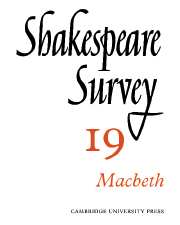Book contents
- Frontmatter
- ‘Macbeth’ in the Twentieth Century
- The Criminal as Tragic Hero: Dramatic Methods
- Antithesis in ‘Macbeth’
- Why was Duncan’s Blood Golden?
- Image and Symbol in ‘Macbeth’
- ‘Macbeth’ and The Furies
- Hell-Castle and its Door-Keeper
- ‘His Fiend-Like Queen’
- The Fiend-Like Queen: A Note on ‘Macbeth’ and Seneca’s ‘Medea
- Shakespeare at Street Level
- New Findings with Regard to the 1624 Protection List
- Shakespeare Productions in the United Kingdom: 1965
- The Royal Shakespeare Company 1965
- The Year's Contributions to Shakespearian Study: 1 Critical Studies
- 2 Shakespeare’s Life, Times and Stage
- 3 Textual Studies
- Index
- Plate Section
Image and Symbol in ‘Macbeth’
Published online by Cambridge University Press: 28 March 2007
- Frontmatter
- ‘Macbeth’ in the Twentieth Century
- The Criminal as Tragic Hero: Dramatic Methods
- Antithesis in ‘Macbeth’
- Why was Duncan’s Blood Golden?
- Image and Symbol in ‘Macbeth’
- ‘Macbeth’ and The Furies
- Hell-Castle and its Door-Keeper
- ‘His Fiend-Like Queen’
- The Fiend-Like Queen: A Note on ‘Macbeth’ and Seneca’s ‘Medea
- Shakespeare at Street Level
- New Findings with Regard to the 1624 Protection List
- Shakespeare Productions in the United Kingdom: 1965
- The Royal Shakespeare Company 1965
- The Year's Contributions to Shakespearian Study: 1 Critical Studies
- 2 Shakespeare’s Life, Times and Stage
- 3 Textual Studies
- Index
- Plate Section
Summary
A good deal has been written about the imagery of Macbeth since Caroline Spurgeon showed that the iterative image was that of a man in ill-fitting garments. It has been pointed out, for example, that the image can be interpreted in more than one way and that we need not necessarily suppose that Shakespeare looked on his hero as a small man in garments too large for him: we may rather suppose that the point of the image is that the garments were stolen or that they symbolize the hypocrisy to which Macbeth is reluctantly committed when he embarks on his career of crime. It has also been pointed out that this particular image should be considered in relation to a wider group of tailoring images, of which the imaginary tailor, admitted by the Porter of Hell-gate, may be regarded as a kind of patron.
What is more important is that, since the publication of R. B. Heilman’s books on King Lear and Othello, W. H. Clemen’s The Development of Shakespeare’s Imagery and G. Wilson Knight’s series of interpretations, Miss Spurgeon’s concentration on a single iterative image, even though numerically predominant, is apt to be misleading. The total meaning of each play depends on a complex of interwoven patterns and the imagery must be considered in relation to character and structure.
- Type
- Chapter
- Information
- Shakespeare Survey , pp. 45 - 54Publisher: Cambridge University PressPrint publication year: 1967

